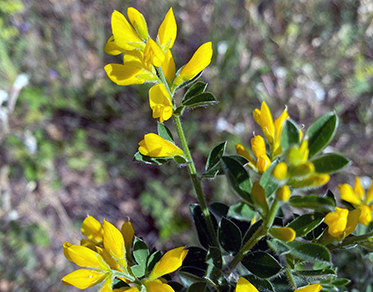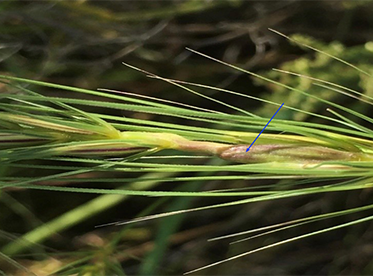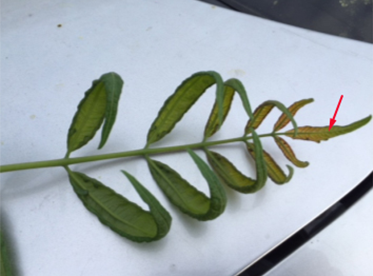Finding Biocontrol Agents for French Broom, Medusahead and Tree-of-Heaven
Since 1919, the European Biological Control Laboratory (EBCL) played a crucial role collecting and providing research and candidate biological control agents to federal and state cooperators for the management of invasive weeds.
EBCL is now entering a new phase with the recently approved five-year research plan (2020-2025). Objectives include foreign exploration for natural enemies of target weeds, population genetic and phylogeographic studies, and selection and evaluation of candidate biocontrol agents.
A total of seven targets belonging to annual grasses (Medusahead and Ventenata), forbs and shrubs (Sahara mustard, stinkwort and French broom), and rangeland and forest weeds (Tree-of-Heaven, Swallow-worts) have been identified.
The proposed combination of importation biocontrol with critical research on factors underlying weed invasiveness and candidate agent biology will lead to ecologically rational, safe, and sustainable management of some of the most important invasive weeds in the U.S.
Besides traditional biological and ecological studies on life history traits of arthropod agents, EBCL scientists developed skills to describe genetic attributes and chemical components for biocontrol agents.
For example, they long used DNA barcoding to identify hidden species or biotypes of natural enemies of weeds that differ in important biological characters, in an effort to increase the number of prospective biocontrol agents available. Recent efforts are undertaken to barcode the assemblage of natural enemies associated with the weeds and to enrich the existing molecular databases.
French Broom
An ecologically sound approach to manage invasive weeds in the U.S. is through the use of insects that feed and damage only the target weed. EBCL identified two insect species that feed and significantly damage French broom, a highly invasive weed in California.

One weevil (Lepidapion argentatum) is both a gall maker and a seed feeder, and one psyllid (Arytinnis hakani) is damaging French broom by sucking the sap from the stems and leaves. These insect species both reduce the weed’s growth.
EBCL researchers are using novel chemical ecology techniques to investigate the olfactory preferences of the French broom psyllid. The main focus is to understand what plant odors attract the psyllid in an effort to predict its behavior in the field when introduced as a biocontrol agent into California.
Research is continuing to determine if these insects only attack French broom before safely releasing them into the U.S. The research will involve outdoor evaluation of two potential biological control candidates which hopefully will lead to the preparation of a petition for eventual release.
Medusahead and Tree-of-Heaven
Exploration in Europe recently revealed potential agents for two targets of particular interest and importance including medusahead rye, which is distributed throughout the Western U.S. and tree-of-heaven, which is predominantly present in the Eastern U.S.
Medusahead impacts millions of hectares of rangelands and tree-of-heaven is highly invasive in field, urban and suburban areas causing significant disturbance of cultivated and natural areas.
Partnering with the Biotechnology and Biological Control Agency in Rome, EBCL employees recently discovered a galling wasp (Tetramesa amica) on Medusahead in Greece. The population is very localized but apparently negatively impacts plant growth by forming galls on the stems (see the arrow in the photo below) that replace seeds.

An eriophyid mite species, Aculus mosoniensis, was found in different European countries always associated with the tree-of-heaven. This mite induces downward rolling of leaves with reddening (see arrow in the photo below). Once infested, the plant growth is reduced.
In 2020, an open field test was initiated at the Biotechnology and Biological Control Agency facilities, exposing tree-of-heaven and 14 nontarget plants species to the biocontrol candidate agent. Results showed a narrow host specificity of the mite, recorded only from the target weed species.

Authors: René Sforza, Marie-Claude Bon, Javid Kashefi, Mélanie Tannières, and Massimo Cristofaro
Contact: Michael Grodowitz, michael.grodowitz@usda.gov
The European Biological Control Laboratory (EBCL) was established in 1991 near Montpellier, France. EBCL was created by the merger of the former European Parasite Laboratory, established in Paris in 1919, and the Biological Control of Weeds Laboratory in Rome. EBCL has a satellite laboratory in Thessaloniki, Greece. As the only USDA ARS-operated laboratory outside the United States, EBCL develops biological control technologies which can be used to suppress invading weeds and insect pests of Eurasian origin. EBCL researchers do this by searching for natural enemies (insects, mites, and pathogens) in their native habitat, determining their identity, testing their host specificity and potential impact in laboratory and field experiments, and shipping promising organisms to the U.S. for further testing as biological control agents. EBCL collaborates with scientists in many countries in Europe, Asia, and Africa to explore in regions of origin of the target weeds and insects.
